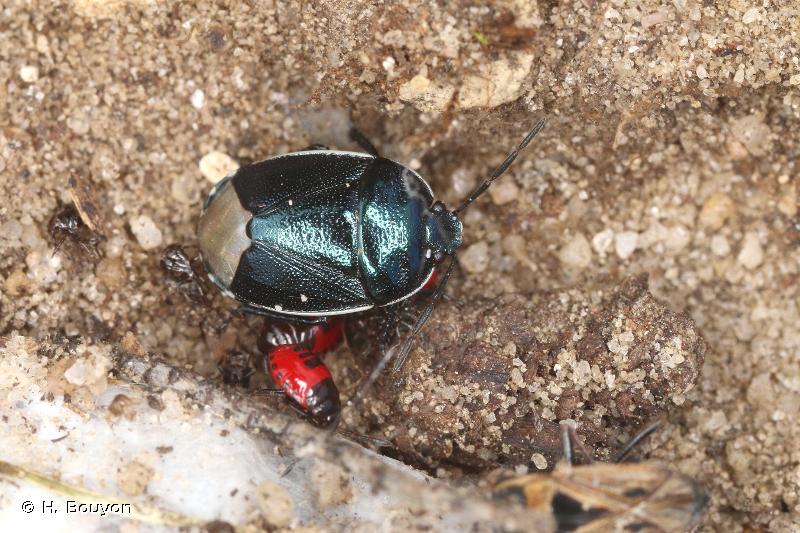
cd_nom

| Author : H. Bouyon |
 |
To get the picture, please visit:
Hervé BOUYON
email : herve.bouyon@wanadoo.fr
Any reuse of one or more photographs on this site is subject to an authorization request from the author.
Link to the Code of Intellectual Property (Legifrance)

| Author : J. Touroult |
 |
To get the picture, please visit:
Julien Touroult
UMS PatriNat AFB - CNRS - MNHN
Muséum national d'Histoire naturelle, CP41, 36 rue Geoffroy Saint-Hilaire, 75005 Paris
Despite the Creative Commons license, please inform the author of the use which will be made of his photo
Taille : 5,5 – 7,5 mm
Diagnose :Petite punaise ovale bleu-noir métallisé avec le thorax (pronotum) et l'abdomen (cories) bordés d'un bourrelet blanc. Elle n'a pas d'épines et/ou de soies sur les bords de la tête, les bords du pronotum et les ailes, et elle a des pattes épineuses (sous-famille des Sehirinae). Les membranes de ses hémélytres sont blanchâtres et translucides, ses pattes sont noires, et la dépression transversale de son pronotum est fortement marquée.
Détermination : Délicate.
Espèces proches :Chez Canthophorus impressus, la dépression transversale du pronotum est profonde alors qu'elle l'est moins chez Canthophorus dubius. Ce caractère étant assez variable, la distinction entre ces deux espèces est très délicate et ne peut se faire avec certitude qu'en examinant leurs pièces génitales sous loupe binoculaire.
Période d'observation : Mai à septembre.
Biologie-éthologie :Canthophorus impressus a été signalé sur plusieurs espèces de thésiums, dont le thésium des alpes à 1 700 m d'altitude. Cette espèce vit souvent en colonies de dizaines d'adultes et de larves, au sol sous les thésiums tapissants. On la repère facilement en recherchant la couleur bleu métallisé caractéristique des adultes et les abdomens rouge vif des larves.
Biogéographie et écologie :Espèce à distribution eurosibérienne présente jusqu'au Kazakhstan à l'est et jusqu'à 57° de latitude nord en Suède. Elle est absente des régions méditerranéennes. Peu de données anciennes existent en raison de sa confusion avec Canthophorus dubius.
Roland Lupoli (),2019
Continental
Metropolitan France
Overseas
Marine
Metropolitan France
Overseas
The map presents a summary at the 10 x 10 km grid of the observation data for the species transmitted to the SINP. These data have been subjected to validation filters.
The map presents a reference distribution layer of the species at the scale of departments and marine sectors. The presence and absence data were established by expertise within a network of partners. This reference distribution is used in the validation process of the SINP data at the INPN level.
Corresponds to a report on the basis of at least one observation proved within a period of 10 years (20 years for little-known invertebrates) preceding the year and no presumption of extinction since obtaining the last data nor doubt on reproductive and implemented nature of this population. For migratory species, the presence indicated concerns areas of reproduction.
This status is based on one or more of the following criteria:
This point covers the absence, more difficult by nature to demonstrate than presence. This status is based on one or more of the following criteria:
This status must be assigned to a department in which the presence of the species is casual.
Particular case of absence due to a proven extinction less than a half century ago (older disappearances are treated as "no probable or definite").
In the state of knowledge, we can not comment on the presence or absence in the current department. This is the default status when not comprised in one of the previous categories or whenever there is doubt.
The map shows the global distribution of the species based on GBIF data (Global Biodiversity Information Facility).
